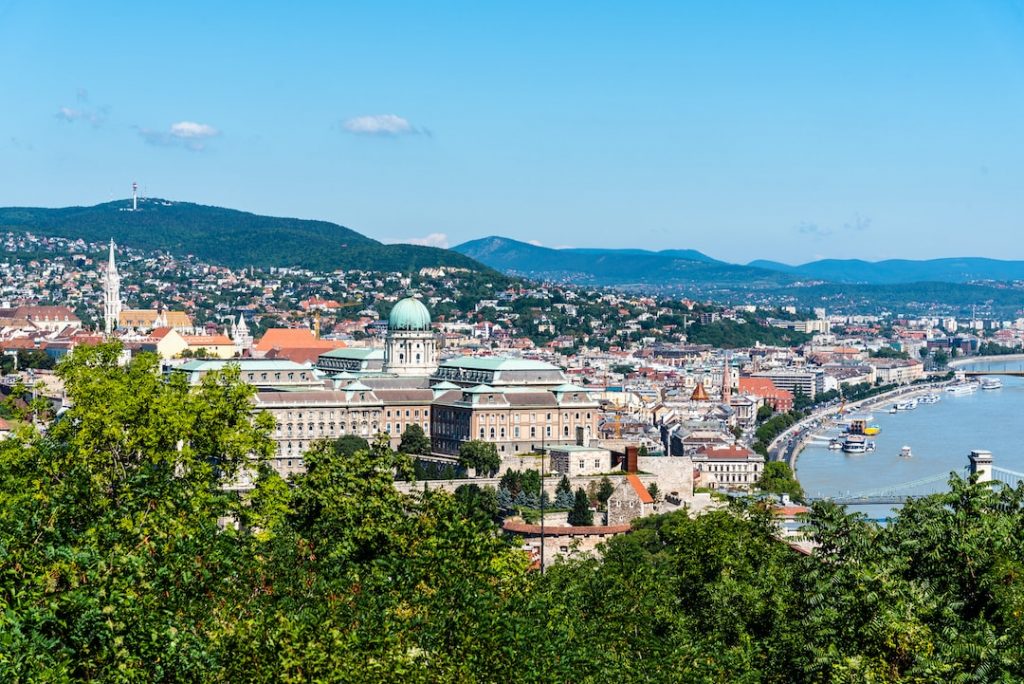
Budapest is a gem of a city. It’s so much more than just the capital of Hungary; it’s full of history and culture.
Budapest is a unique city to visit for many reasons, but what’s really neat is that it’s easy to get around.
The best way to experience Budapest, Hungary, is by staying in the city for at least three days. There are plenty of museums, restaurants, and street performers that will make your time there all the more enjoyable.
In the warmer months, you can go to the thermal baths or take a walk in one of the many parks. The city’s architecture is spectacular, and there are plenty of photo opportunities around every corner.
And be sure to obtain a Budapest card so that you can have unlimited access to public transportation.
Why go to Budapest?
Budapest is not just the capital of Hungary – it’s the center for business and culture. From its multi-sensory restaurant scene to its rich Jewish world heritage, cultural diversity covers almost every inch of the Persian of Danube.
Budapest is situated on the border of the Danube river and comprises three large parts: Pest, Buda, and Óbuda.
These three parts are now part of one city, but they were separate cities at different times in history.
- Pest
The Pest side is a more modern area of Budapest than Buda. Home to important buildings like the Museum of Fine Arts, Parliament, Kunsthalle, and MOKKA Centre, Pest is also the location of City Park (the city’s biggest park) and Szentendre that houses galleries and restaurants.
- Buda
The part of Budapest known as Buda has a lot to offer when it comes to historical sites. It is the site for the Royal Palace (seat of Hungarian kings from 1541-1916), Matthias Church, Fisherman’s Bastion, and Citadella.
Notable areas include Castle District (homes of the nobility and aristocracy) and Gellért Hill with its Citadel, Liberty Monument in the Gellért Baths area, and Holy Trinity Square with its Basilica.
The Buda side also includes the Liberty Monument at the site of the former bath that now serves as an outdoor concert arena for classical music concerts. And lastly, there’s Holy Trinity Square with its basilica, which houses Hungary’s largest organ.
- Óbuda
Óbuda is an ancient district occupied at various times by Bulgarians followed by Romans before it became a predominantly Romanian neighborhood during medieval times.
Today’s attractions are mostly related to culture or nature, which includes Budapest’s biggest park—City Park that has many festivals such as Sziget Festival every summer.
There’s also Óbuda castle with Hungary’s most famous museums, the Kodály Museum and Hungarian National Gallery.
Now that you have a good sense of the layout of Budapest let’s dive into the 12 unique experiences you must have while visiting there.
#1: Szabó’s Damm
Many memorials speak to the importance of the Siege of Budapest.
The 19th-century Szabó’s Damm memorial is situated on Váci út, a street that goes right through the center of Budapest. Unfortunately, the memorial is a little hard to find, but if you make an effort, it’s worth it.
This was one of Hungary’s most tragic moments in history, and this site commemorates those Hungarians who died defending their country against Soviet armies during World War II.
The Hungarian government pulled out all the stops for this commemoration by erecting colossal monuments currently on display at Szabó’s Damm section (located right next to Radisson Blu Congress Hotel).
The experience is designed with audio recordings and lights to tell the story of what happened during the siege to those who visit today. It’s a place for reflection and remembrance.
#2: Műcsarnok Museum
Designed by Hungarian architect László Hudec, this Budapest museum brings together old and new, from the medieval Matthias Church to contemporary art.
Located on the bank of the Danube, this multi-tiered structure has many stories and a beautiful interior courtyard. The permanent art collections include over 3,000 pieces from Europe, America, and Asia representing historical and contemporary periods.
#3: The Royal Palace
Designed by Italian architect, Ányos Jedlik in 1851, the Budapest Royal Palace is often called “the city’s second heart.”This is because itt served as Hungary’s Parliament during WWII and still does today for ceremonial occasions.
This beautiful building has a lot to offer: surrounded by gardens that have been tended since 1630, there are two museums inside which document all of Napolean’s advances with history books telling about the significant role it played in his final defeat at Austerlitz!
#4: House of Terror Museum
Do you want to learn about Budapest’s history through a different lens? Then, visitt the House of Terror Museum.
This museum is one that both locals and tourists recommend because it won’t just tell you what happened here and how people have coped with these tragedies, which makes for an interesting experience whether or not you speak traditional Hungarian!
#5: St. Stephen’s Basilica
The St. Stephen’s Basilica is the most famous church in Budapest and has been since 1854 when it was built following Hungarian architect Miklós Ybl’s plans for a parish church to replace an older one from 1768 (which had burned down).
It took over two years of construction work before its unveiling on September 11th, 1856, with some amazing features like statues made by Michelangelo or other artists imported here along with paintings depicting Jesus’ crucifixion on the walls inside.
#6: The Hungarian Parliament Building
The Hungarian Parliament Building is the most recognizable in Budapest thanks to its unique architecture created by Imre Steindl and Ferenc Kőrösy following a neo-gothic design.
The architecture considers such features as some Neo-Gothic tracery while maintaining a style that blends beautifully with the surrounding buildings. This project has been in construction since 1875 and was not completed until 1902.
#7: The Heroes’ Square
The Heroes’ square is a beautifully designed space in Budapest that honors those who sacrificed their lives for the nation. It was built in 1949, and they use it to celebrate important events such as national holidays, military and political anniversaries, or state funerals when veterans are given awards for bravery.
#8: Hungarian National Museum
The Hungarian National Museum is the institution responsible for preserving and promoting Hungary’s history.
It was founded in 1847 by Károly Lotz, a painter who also served as its first director until his death eight years later due to cholera.
#9: Danube Cruise
Take an evening river cruise along the Danube. You’ll be able to see all the beautiful landmarks lit up at night as you enjoy dinner and wine.
The cruise gives you access to parts of the Danube in Budapest that you can’t reach by walking or using public transportation. Seeing Budapest by water is a great way to see some amazing sites like the Parliament Building lit up at night.
#10: The Magic Flute
Watch a production of Mozart’s Die Zauberflote (The Magic Flute). This state opera will transport you back to when Wolfgang Amadeus Mozart first performed this classic at Vienna’s Burgtheater in 1791.
Performances take place in Budapest every day from May through October, so there won’t be a problem finding the right date.
#11: The Buda Castle District
The Buda Castle District is the location of many significant sites, including Saint István’s Square Fisherman’s Bastion and Matthias Church.
Along with the many important historic buildings, it has several museums like Riposte, which focuses on modern art in Hungary.
#12: Andrássy út
Visit Andrássy út, Budapest’s most famous boulevard – a long, tree-lined street with beautiful castles and museums on either side. You’ll be able to see some of Hungary’s rich history here as well as enjoy shopping for souvenirs at one of the many stores that line this avenue (closed Mondays).
#13: Szechenyi Baths
Szechenyi Baths, located in Buda, have an ancient feel to them.
This is an architectural gem designed by neoclassical Hungarian architect Ödön Lechner who also created Budapest’s first National Theatre!
#14: Margaret Island
Explore this island by renting bikes from a nearby rental shop. It’s not too far away from the city center. Here you will find several attractions such as Vajdahunyad Castle (Hungary’s answer to Neuschwanstein), The Musical Fountain Show, Labyrinth Garden, and the Zoo and Botanical Garden.
#15: Watch the Sunset from Liberty Bridge
There is nothing more spectacular than watching the sunset over Budapest from Liberty Bridge. You’ll be able to take in views of Parliament, Castle Hill, and Fisherman’s Bastion lit up at night as well!
#16: Visit the Ruin Pub Scene
Explore the Ruin Pub scene on Kazinczy Street or Nagymező utca. This area is great for mingling with locals who love good food & drinks.
This street, which runs down into the Jewish Quarter of the Pest side district, is lined with one atmospheric ruin pub after another.
#17: Széchenyi Chain Bridge
The Széchenyi Chain Bridge located between Buda and Pest is one of the most famous bridges in Budapest.
It was designed by English engineer William Tierney Clark and built between 1839-1849 with help from Ottoman authorities, who provided some funding for its construction. It’s a major landmark symbolizing both Buda and Pest and connecting the two banks of the Danube River.
The bridge is one of Hungary’s main tourist attractions, not to mention it has become an icon that represents Budapest!
The Bottom Line
Budapest is a place of unique experiences. As you can see from the 17 suggestions above, there’s plenty to explore in this city.
